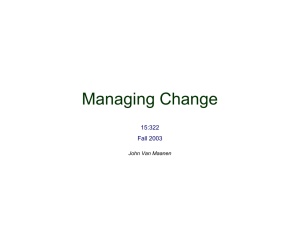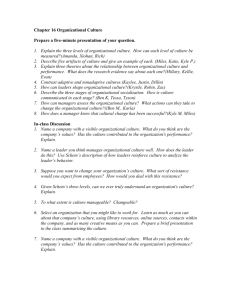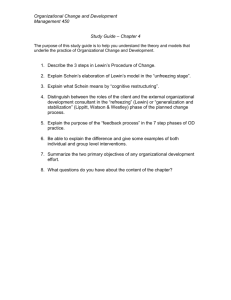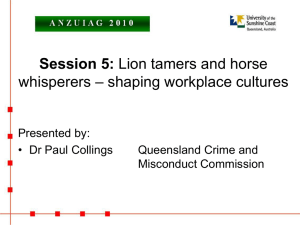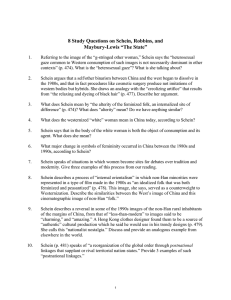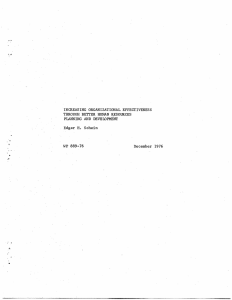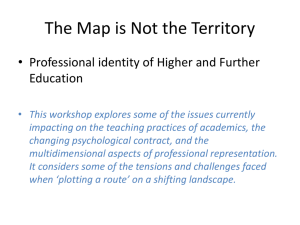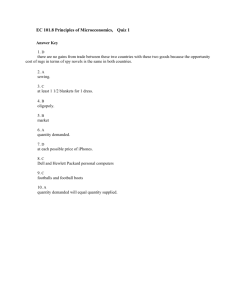Schein
advertisement
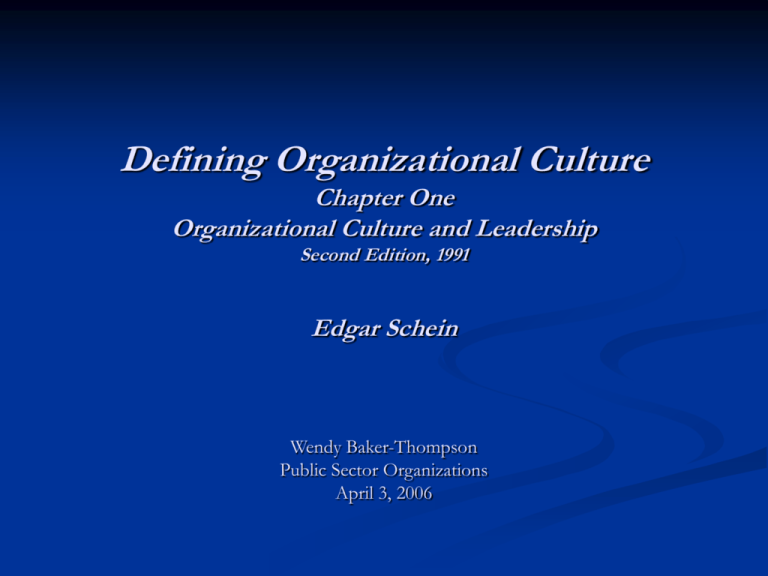
Defining Organizational Culture Chapter One Organizational Culture and Leadership Second Edition, 1991 Edgar Schein Wendy Baker-Thompson Public Sector Organizations April 3, 2006 Edgar Schein Born 1928 Sloan Fellows Professor of Management Emeritus and Senior Lecturer at Sloan School of Management in Massachusetts Institute of Technology Founding editor of Reflections - journal of the Society for Organizational Learning Author of numerous books and articles Organizational Culture and Leadership among the most notable studies of organizational culture Education: University of Chicago (undergraduate) Stanford University (MA Psychology, 1949) Harvard University (Ph.D. Social Psychology, 1952) “Culture is an abstraction, yet the forces that are created in social and organizational situations that derive from culture are powerful. If we don’t understand the operation of these forces we become victim of them.” Schein, E. (2004) Organizational Culture and Leadership, Third Edition Schein’s formal definition of organizational culture: “A pattern of shared basic assumptions that a group has learned as it solved its problems of external adaptation and internal integration, that has worked well enough to be considered valid and therefore, to be taught to new members as the correct way to perceive, think, and feel in relation to those problems.” Three Levels of Organizational Culture Cultural Artifacts Levels of Expression Technology, things and Readily observed: Multiple cultural meanings Behavioral patterns Values Testable in the physical Environment and by social consensus Observable patterns of meanings Basic Assumptions Relationship to the environment Nature of reality, time and space Nature of human nature and Human relationships Not directly observable and must be inferred from observations of the culture Lawson & Shen (1998). Organizational Psychology Schein’s Examples (of how culture helped clarify specific organizational situations) Company 1 – Goal: develop innovative climate; one flexible to environment Findings: a lot of innovation but not communicated; no management support for communication Recommendation: better listening, less interrupting, more orderly agenda, reduce frustration level Company 2 – Goal: improve communication, relationships, decision making Findings: competition, emotionalism, frustration in communication Recommendation: increase communication efforts, sharing of innovative ideas In both cases, suggestions made for reducing factors identified yet styles remained same despite recommendations. Problem? Assumptions – Schein was looking at both companies with his own eyes, his own culture and not those of the company How he thought things should work was not the same as the way his clients thought things should work Schein realized the importance of confronting fundamental assumptions Cultural analysis is “the encountering and deciphering of shared basic assumptions” Major concepts (associated with culture) Observed behavioral regularities in interactions (language, rituals) Group norms Espoused values Formal philosophy Rules of the game Climate Embedded skills Habits of thinking, mental models and/or linguistic paradigms Shared meanings “Root metaphors” or integrating symbols Culture implies structural stability and patterning or integration Culture Formation Culture Human need for stability, consistency & meaning Stability of membership Shared Learning History of shared experience Group Three Elements of Culture The problem of socialization – teaching newcomers The problem of behavior – cultural predisposition and situational contingencies Can a large organization have one culture? – Subcultures are a normal process of evolution (due to different experiences and different sets of assumptions) Subcultures often conflict with one another (management and unionized labor groups) Common assumptions come into play during crises Culture and Leadership Leadership and culture must be looked at collectively – neither can be understood by itself Leaders should be conscious of culture otherwise it will manage them Cultural understanding is essential if leaders are are to lead: When leaders create groups and organizations they create cultures Once cultures exist, leaders determine criteria for leadership (who will and will not be a leader) Dysfunction = requirement of leaders to identify the functional and dysfunctional elements and manage evolution and change in order to survive A strong organizational culture controls organizational behavior and can block an organization from making necessary changes for adapting to a changing environment Cultural Change Change of culture is a major investment of time and resources Attempts to change organizational culture can be harmful In some situations organizational change should not be tried (any examples of these situations?) (J. Steven Ott, Understanding Organizational Culture) Challenge of those embedded in the culture to see their reality as something they constructed and see meaning in what is taken for granted Value attached to assumptions Culture taken for granted – not discussed and therefore seemingly unconscious Emotional investment leads to being defensive rather than examination (of assumptions) Organizational Culture Formal Philosophy - The “HP Way” Hewlett Packard founders – Bill Hewlett and Dave Packard Hewlett Packard prided itself on a management philosophy emphasizing integrity, respect for individuals, teamwork, innovation, contribution to customers and community. Egalitarian, decentralized system – “employees the most important resource” Philosophy built loyalty of many thousands of employees since founded 63 years ago Passed away in 1996 and 2001 Legacy was not of multi-billion dollar technology giant, but instead of the “HP Way” Passing of founders and increasingly competitive environment may be demise of the “HP Way” Market forces – one of the most controversial mergers ever – HP and Compaq (49% of HP Shareholders voted against merger) New CEO in 1999 hired from outside the company so without history of the “HP Way” Hired by the board to “shake up” the organization Criticized for disregard to employees and culture of teamwork and trust Was it really about employees’ resistance to (necessary) change and not about the new CEO? Source: Palo Alto Weekly, April 10, 2002 http://www.paloaltoonline.com/weekly/morgue/2002/2002_04_10.hpway10.html Other Key Points Because basic assumptions and the factors shaping organizations differ, every organizational culture differs Not every “collection of people” develops a culture Reasons : Insufficient stability of membership Insufficient shared history of experience Presence of too many subgroups with different kinds of shared experiences Problems that all groups regardless of size, encounter: Survival, growth and adaptation in their environment Internal integration that permits daily functioning and ability to adapt For discussion The “HP Way” Experience with being a “newcomer” and being subjected to the “way we do things around here?” Any unique factors to your organization’s culture? Experiences with organizational change – success/challenges? The End
